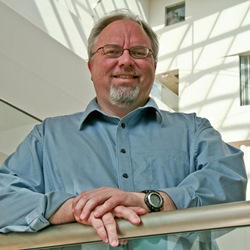
Molecular Mechanisms Underlying Heterogeneity of Neurotransmitter Release Probability at Synapses
Description
The major focus of our research has been to characterize the molecular machinery that mediates synaptic communication using the Drosophila neuromuscular junction (NMJ) as a model glutamatergic synapse. We performed extensive structure-function analysis of the synaptic vesicle protein Synaptotagmin 1, demonstrating that it functions as the Ca2+ sensor for fast synchronous synaptic vesicle exocytosis, while suppressing slow asynchronous release. By employing conditional mutants in Drosophila SNAREs and NSF, we found that synaptic exocytosis requires rounds of SNARE assembly and disassembly, and that NSF functions in a post-exocytotic role to break apart SNARE complexes after fusion. We identified the SNARE binding protein Complexin as a fusion clamp for synaptic vesicle exocytosis in vivo, while demonstrating it enhances the speed and amount of evoked exocytosis by regulating Synaptotagmin-SNARE interactions. Another interest of the lab is to characterize how synapses undergo plasticity to change their properties based on patterns of stimulation. We found that Drosophila NMJs undergo robust stimulation-dependent synaptic plasticity that is initiated by postsynaptic Ca2+ influx through glutamate receptors and the release of retrograde signals that activate PKA and enhance presynaptic release. We found that PKA phosphorylation of the fusion clamp Complexin was the presynaptic trigger for elevating release, while Synaptotagmin 4 (Syt 4), an evolutionarily conserved Syt homolog that localizes to the postsynaptic compartment, regulates Ca2+-dependent postsynaptic vesicle trafficking and the release of retrograde signals that trigger synaptic growth and plasticity. We identified Syntaxin 4 as the key postsynaptic t-SNARE and showed that Neuroligin was a target for Syntaxin 4-dependent postsynaptic trafficking. Expanding beyond the genetics of synaptic transmission, we developed transgenic tools to optically visualize single synaptic vesicle fusion events at individual active zones (AZs), allowing us to define general rules for vesicle fusion at single release sites. Although Pr is very heterogeneous across the ~300 AZs between synaptic partners at the NMJ, it represents a stable and unique feature of each AZ. We find that Pr is strongly correlated with presynaptic Ca2+ channel density and Ca2+ influx at single release sites. In addition, Pr variability is reflected in the postsynaptic compartment, as high Pr AZs display a distinct pattern of glutamate receptor clustering. Determining how high Pr sites emerge and how they can be regulated during presynaptic plasticity is a current focus of our research.
Speaker Bio
Troy Littleton, M.D., Ph.D., is a Professor of Neuroscience in the Departments of Biology and Brain and Cognitive Sciences and The Picower Institute for Learning and Memory at MIT. Troy earned his M.D. and Ph.D. degrees in the Medical Scientist Training Program (MSTP) at Baylor College of Medicine with Hugo Bellen characterizing synaptic vesicle exocytosis using the Drosophila model. After completing his M.D./Ph.D. studies, Troy did postdoctoral work with at the University of Wisconsin in Madison with Barry Ganetzky, one of the early founders of the Drosophila neurogenetics field. Following post-doctoral work, Troy moved to MIT in 2000, where the lab has been characterizing basic features of how synapses form, how they transmit information and how they undergo functional and structural plasticity. The lab is also actively dissecting the mechanisms of neurotransmitter release and retrograde signaling at synapses. More recently the lab has also been interested in the mechanisms and functions of glial-neuronal signaling in the brain. In addition, the lab is using Drosophila models to study several neurological disorders, including epilepsy, Huntington’s Disease, and autism. Troy has received numerous awards for the lab's research, including a Helen Hay Whitney Fellowship, a Searle Scholar Award, a Sloan Research Fellowship, a Human Frontiers Science Program Fellowship, the Poitras Scholar Award in Neuroscience and a Packard Foundation Fellowship for Science and Engineering. In addition, Troy has served as a member of numerous NIH Study Sections and mentored more than 60 students and postdoctoral fellows during his career. Currently, he serves as Director of MIT’s Molecular and Cellular Neuroscience Graduate Program.

